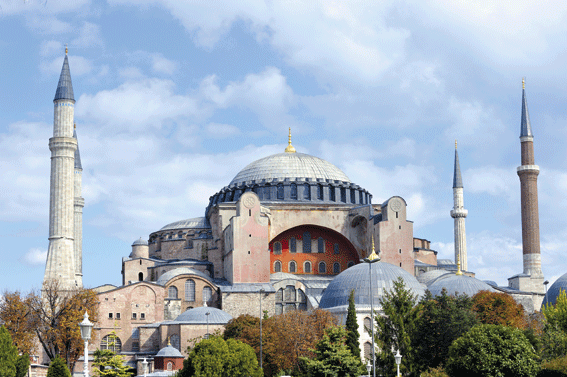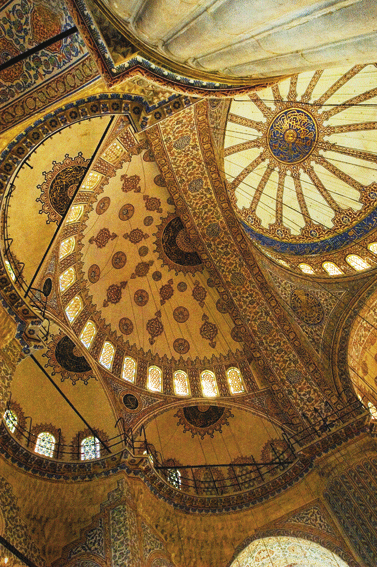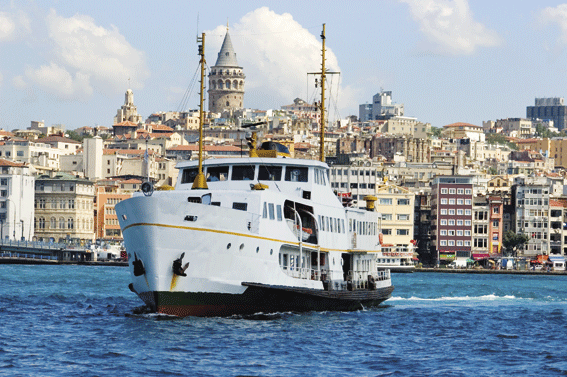

Istanbul
A Tantalizing Sojourn
Visiting Istanbul is like going into a picturesque past
 |
Blue water, tall and auspicious buildings, immense architecture, picturesque markets and food,
it is audacious. These tantalizing images remain imprinted on your mind long after you left the place.
By Marwan Asmar
Istanbul is charming, exhilarating, quaint, out of a history book, replicating tradition with modernity. Its architecture is a mosaic intertwined with skyscrapers, high-towers and long minarets, a geographical tapestry underlined by horizon-domineering mosques, constant blue seas, historical palaces and castles.
To the first timer, or maybe the 10th-timer, Istanbul is dazzling, replenishing your mind with its constantly beguiling images, sharpening your senses and enchanting in what you see and experience.
In Istanbul, the cool, relaxing, enticing blue water constantly surrounds you wherever you look. People are happy, talkative and delightful. From the south, it is the Marmara Sea, the north it is the Black Sea connected by the historically famous Bosphorus Straits. Next to that is the Golden Horn estuary, an inlet, and an additional source of connection.
I was being pampered. It was a slick, dynamic tour that began with travelling Business Class from Amman. Next to me was a businessman who came especially from Kuwait to be on this trip that had all the trappings of luxury. After saying our goodbyes to the chattering of Spaniards, and a good deal of other vocal sounds, we went our separate ways.
The first night I was booked into Istanbul’s Marmara Hotel, being told this is where top Turkish politicians and decision-makers frequently stay. It was nice, auspicious and clean but then moved to the Intercontinental Hotel.
The rooms in both establishments provided a marvelous birds-eye view of the Bosphorus and its tipping blue waves that shine-radiated under the sun and the city landscape with the Sultan Ahmad Mosque, being at the far-distant corner, a marvelous wonder of six minarets.
We were in the famous Taqsim Square, and just beyond that, the well-known Istiqlal Street, stretching as far as one can gaze. This is one of the famous attractions of modern Istanbul, and not because of its chic and boutique shops, pastries, diners, and traditional restaurants, but because of the other natural element that made the street so famous for.
Its waves upon waves of people, night and day, are, by themselves extraordinary. “Where are these people going,” I kept wondering. Being a sojourner myself who was trying to find my whereabouts keeping that to myself though, despite the fact my brother and his Turkish colleague were waiting for me, as I landed at the airport.
There was no actual shoving, but a constant popular stream. At any one time there couldn’t have been a meter-length between me and the people in front. I was told Istanbul had a population of about 14 million, and an additional 5 million that frequented the city every day, very likely a huge number of them were walking the street! 
After gulping down the rice-pudding-like mahlabia in one of the pastry cafes, we took a left turn where we found ourselves underground amongst thousands upon thousands of valuable secondhand books at dirt-cheap prices.
Having pushed by the posh bookshops on the Istiqlal Street, as I am a stickler for good, design-captivating covers, I was now amidst the heartrending little bookshops that spewed an old and trusted culture for an inveterate dilettante who loses himself among the stained pages of hack-writers.
Of course most were in Turkish and of fiction translated into that language, but many others were in English—a litany of a literary world that spanned from the classics to the intellectual gurus of modernism, and underpinned by the myriad of textbooks for the inspiring student.
I quickly took to these like a fish to a bowel of water and started thumb-flicking the pages. The very idea of going through this little underground arcade was a testimony to a living reading aura that perforated the hustle and bustle of the walks on the above ground.
Back at the hotel, my room shone with lights as I looked on the Bosphorus and the rest of the city. Night bulbs and flickers gave in to much imagination about a city that was rich-deep in historical limelight for the topping of the cake was in the Sultan Ahmad Mosque, the Hagia Sophia and the Topkapi palace, with the last two becoming museums to a splendid Islamic and Ottoman past.
The Sultan Ahmad Mosque, a 17th century piece of architecture, and built between 1609-1616, is a glorious edifice underlined by the great number of visitors, who come here to look at this wonderment.
Our car lightly treaded on the tight, but car-filled road trying slowly to move to the structure. We stopped opposite to the site and courtyards housing the mosque, while our driver-friend moved to look for a car-space up beyond.
The popular wave on Istiqlal Street, almost repeated itself on the outer courtyard leading to the Mosque. It was hardly believable, hundreds of visitors, nay thousands, from virtually what looked like every corner of the globe, were coming to see the mosque, they were in its courtyards, up its steps, inside the mosque itself, with some covering their mouths with their fingers in a state of awe.
After making our ablutions, we quickly made our away inside the Mosque amidst the soft pushing of the people waiting to enter a piece of Islamic history. First we performed our prayers, and then began flicking the cameras like everyone else.
The Blue Mosque was covered by blue Isnik tiles that reflected among the sun. The great edifice on the outside transformed itself on the inside. The mere sensation of this religious establishment represented itself in its rich red-and-white decorative carpet that stretched from one end to the other, the arches, walls, lights, the tainted windows and great dome and the mini-domes. The Islamic calligraphy written all over was humbling to the soul and the spirit.
Opposite the Blue Mosque stood the Hagia Sophia, an awesome structure that also foretells of a celebrated past. Having been turned into a museum in 1935, previously it was a place of Islamic worship since the mid-15th century.
Its magnificent architecture from the outside is once again repeated from the inside with its huge religious space on the inside that has been kept to speak of religious and cultural co-existance.
The believing is in the seeing as no amount of words can describe the images of these institutions that have come to speak of a religious culture, as spoken by the mass amount of people coming in droves to experience the spiritual feeling.
Earlier that day, we had taken our lunch by the forefront. We had chosen our fish, and a very large plate of fresh sardines, and were waiting for them to be grilled under a canopy. “Up there are what are called the Princess Islands which you can go to by boat,” our Turkish friend was pointing his finger. I read later that these 9 small islands, 5 of which are occupied, may indeed be reached by boat and some no doubt rich Istanbulis, have some of their summer houses there, a wonderful place of seclusion for those who want to get away from the rat-race.
But when anyone goes to Istanbul, it should be for the dynamism, not for the exclusion and the hermetic style of living, basking in a city of culture and recognized so. This year for instance, its being designated by the European Union as the 2010 European capital of culture from the fact that it is situated on two continents, Europe and Asia.
Culture and the intertwining of civilizations, first Byzantine and Islamic continue till the present. At the Galata Bridge, and after praying at the equally dominating Yeni Mosque, we boarded the ferry to take a short trip on the Bosphorus. It was at the popular rate, rather than take a special ferry with dinner which many people do together with a guide to tell them exactly which is which as they maroon part of the 32-kilomer Strait.
I was told night time cruises are very popular, but our tour was at 1 pm time. There are fixed time-tables and these ferries run at regular intervals, lasting for anything up to an hour. You see Istanbul from the blue waters and from afar, it’s like someone has taken a brush and itched the area on canvas.
This was a short trip but culturally enlightening with palaces—including the Dolmabahce, but others equally famous—and for-tresses, mosques, two large suspension bridges, towers and pavilions all amongst the colored houses and villas. On the front, there was as well a little sign from where the ferry was moving saying the Four Seasons Hotel.
It was really a trip of discovery, moving on the boat from one end to the other and from one side to the next, trying to catch the breathiness of it all, despite the chill and breeze though this didn’t stop us trying to consume the sense of history amidst.
It seemed too quick for the mind to comprehend and understand what was behind some of these structures, but it all became an extension of what lay ahead in the Topkapi Palace, located just behind the Sultan Ahmed Mosque and constructed between 1460 and 1479.
Topkapi was used as administrative center for the Ottoman Empire and residence of its sultans. Architecture at its most decorative best, the place grounds had different and auspicious buildings, gardens, courtyards, pavilions, towers and a library that was specifically built in 1719. Topkapi, today, certainly provides a graphic picture of how the sultans and their entourage lived.
The palace stretched for a good few kilometers, at least, and needed much more than an hour or two allocated to different edifices and to know what they were used for. I was tired, and certainly needed a rest, which we found at the downward end of the complex facing the Marmara waters. There was a pleasant café, full of tourists, among which were Japanese that offered the pleasant surroundings of resting ones soaring limbs.
Back at the hotel, we circumvented the Istiqlal Street. It was late dinner at the top floor, splashing at the whole of the lit city, and to the soft delight of oriental music. This was the soothing finale to a trip back home. But Istanbul needs more than three or four days, about a week at the very last, to fathom its structure developed over many centuries.